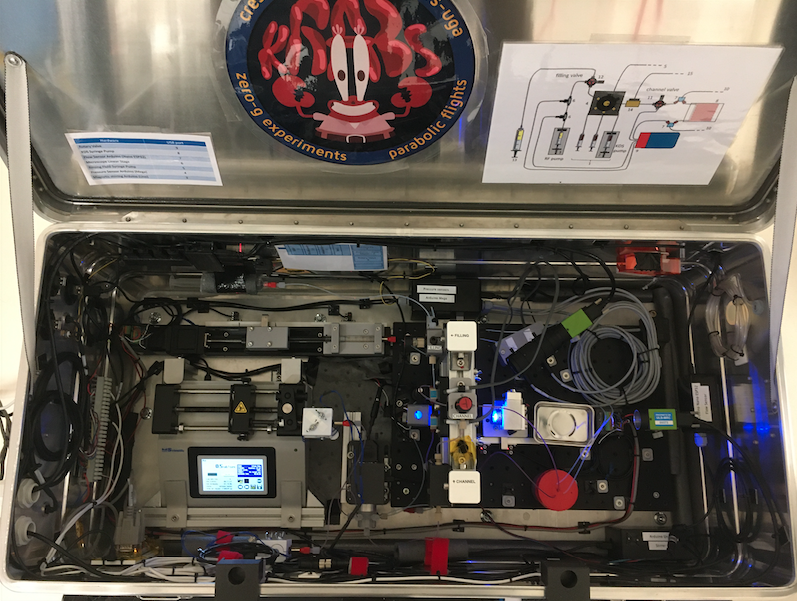KRABS - Kinetics of Red cell Aggregation and Blood Structure-rheology link
Laboratories : LRP, CREST

Blood plasma proteins, notably fibrinogen, are responsible for the aggregation of red blood cells that occurs at low flow velocities and is responsible for a sharp increase in blood viscosity. It has been observed in astronauts in long-duration spaceflight that phases of quasi-stagnation or even reversal of the flow in the jugular vein could occur, during which one can suspect a strong influence and a reinforcing effect (positive feedback) of the aggregation of red blood cells and the resulting increase in viscosity.
Following previous studies on blood cell dynamics in microgravity and on the ground [1-3] and interest in improving the understanding of fundamental mechanisms of red blood cell aggregation [4], the KRABS project was selected by ESA for sounding rocket experiments (planned for MASER 17) and a parabolic flight setup was developed and has been flowing in several CNES and ESA parabolic flight campaigns since 2023. The objective of the experiment is to carry out the first quantitative study of the kinetics of aggregation and variations in associated blood viscosity during slow and unsteady flow sequences. These situations have been studied very little until now despite their relevance to pathological situations and space flight. This experiment is carried out in channels representative of the flow conditions in the veins, by characterizing the aggregation using optical techniques (microscopy, light scattering) and by simultaneously measuring the instantaneous viscosity. So far, these experiments have been successful. They have allowed to refine techniques and protocols for future experiments and provided accurate evaluations of aggregation timescales and related rheological changes.
These studies provide crucial information for the understanding and modeling of blood rheology, blood circulation disorders associated to space flight as well as aggregation related pathologies.
Aggregation of red blood cells and rouleaux formation (linear aggregate structures) during flow arrest.
Related references :
[1] X. Grandchamp et al. Lift and Down-Gradient Shear-Induced Diffusion in Red Blood Cell Suspensions. Physical Review Letters 110, 108101 (2013) https://doi.org/10.1103/physrevlett.110.108101
[2] T. Podgorski et al. Red Blood Cell Dynamics: The Contribution of Microgravity in the BIOMICS Project. In Preparation of Space Experiments. IntechOpen (2020) https://doi.org/10.5772/intechopen.93471
[3] C. Minetti et al. Dynamics of a large population of red blood cells under shear flow. Journal of Fluid Mechanics 864, 408 (2019) https://doi.org/10.1017/jfm.2019.42
[4] M. Puthumana Melepattu et al. Dissociation of red blood cell aggregates in extensional flow. Physical Review Fluids 9, L071101 (2024) https://doi.org/10.1103/physrevfluids.9.l071101
